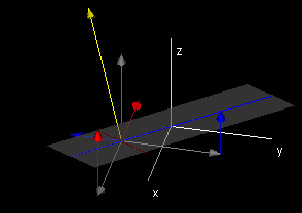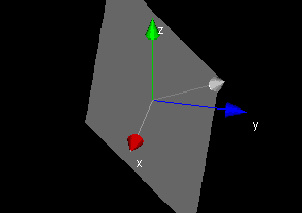|
Normal Vectors for Linear Function Graphs
Text A normal vector to a linear function graph is any vector which is perpendicular to that function graph.

One way to find such a vector is to use the fact that two nonzero vectors with a dot product of zero must be perpendicular. If we know two vectors that are parallel to the plane but not parallel to each other, we can find a normal vector by finding a vector whose dot product with each of these two vectors is zero.
For example, for the graph of the function
f(x, y) = px + qy + k,
we can choose the vectors (1, 0, p) and (0, 1, q), both of which are parallel to the function graph. For any normal vector N, it must be true that
N⋅(1, 0, p) = 0 and N⋅(0, 1, q) = 0.
This gives us a system of two linear equations for the three components of N, resulting in a range of possibilities. We can add the restriction Nz = 1 and we get
N= (-p, -q, 1).
We can use the same method for the graph of the implicit function
ax + by + cz = d.
Two vectors which are parallel to the graph but not to each other are (c, 0, -a) and (0, c, -b).
Again, we have a system of two linear equations for the three components of N. This time, we can add the arbitrary restriction x = a and we get the normal vector (a, b, c).

Demos
Normal Vectors for Linear Function Graphs

| 
|
This demo illustrates the example discussed above involving the function f(x, y) = px + qy + k, two vectors (1, 0, p) (components shown in red and gray) and (0, 1, q) which are parallel to this plane (components shown in blue and gray), and the normal vector (shown in yellow) (-p, -q, 1), which is perpendicular to both of these vectors. Note how the components of each of the first two vectors relate to the components of the normal vector. 
|
Normal Vectors for Linear Function Graphs

| 
|
This demo shows the graph of the plane for the implicit equation ax + by = c and the normal vector (a, b, c) (in white). The x,y, and z components are shown in red, blue, and green, respectively. 
|
Exercises 1. Find normal vectors for the graphs of the following explicit linear functions:
- f(x, y) = 0
- f(x, y) = 2x
- f(x, y) = 3y
- f(x, y) = 2x + 3y
- f(x, y) = 6x + 11y
2. Find normal vectors for the graphs of the following implicit linear functions:
- x + y + z = 1
- 3x + 4y + 5z = 12
- 5x + 3y + 4z = 12
- 4x + 3y + 5z = 1
- y = 23
- x = 7
- z = 9
3. How does any general expression for the normal vector to a plane depend on k for f(x, y) = px + qy + k and d for ax + by + cz = d. Why is this?
|